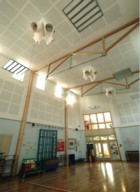Primary school shows the way to a sustainable future

Among a range of Passivent natural-ventilation equipment installed in a new primary school in Altrincham are Airscoop units in the main hall.
Among a range of green-engineering solutions serving a flagship primary school in Altrincham is Passivent natural ventilation. Other features include solar panels, rainwater harvesting and a wind turbine to generate electricity. Pupils and staff at Navigation Primary School built for Trafford Metropolitan Borough Council, can also monitor the consumption and generation of energy via a display on a plasma screen. All these engineering features were incorporated at design stage. To test the design theory, thermal modelling was carried out by Passivent and De Montfort University. It showed that the combination of cross ventilation and stack ventilation achieved the air-change rate of 8 l/s required by current DfES guidelines. The modelling also showed that the glazing specification could be reduced without affecting the amount of natural daylight, whilst reducing solar gain. Cross ventilation exploits natural pressure differences across the building and can achieve penetration depths up to five times the floor to ceiling height. Passive stack ventilation enables rising hot air to draw warm, stale air from the new 2-storey building — encouraged by air moving across the roof. The school was designed with high ceilings to encourage heat generated by pupils and staff to rise and maintain the desired occupant temperature at occupant level. Each of two windows in each classroom incorporates a Passivent Aircool ventilator to provide cross ventilation. They are linked to an energy-management system that monitors carbon-dioxide levels. There are also three Aircool units at high level in the glazing of the entrance hall and three at low level. Each Aircool uses only 1 W of electricity to actuate its louvres and ventilate the space. Warm air is drawn upwards by nine Passivent high-capacity terminals on the roof. In the main hall, three Passivent Airscoop DAD (direct air dispersal) units on the roof draw fresh air into the space below and simultaneously exhaust used air. They are driven by wind power alone. In the infants’ library and the two corridors, Passivent Litevent units provide natural ventilation and natural daylight. Each Litevent provides of 0.6 m2 daylight area with up to 88% light transmission and nearly 0.6 m2 of ventilation. Rising warm air is channelled into the glazed dome and outside through ventilation doors on all four sides of the unit. Architect for the project was Ansell & Bailey, and M&E consultant was SI Sealy & Associates.
Related links:


